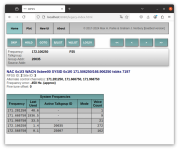luciano_frc
Member
- Joined
- Jan 15, 2024
- Messages
- 11
Hello, dear radio listeners
I have a RTL-SDR Blog V4 dongle, which I bought about a year ago.
In my region, I have many DES-OFB op25 transmissions and very few unencrypted transmissions.
I have tried a few things to be able to listen to the transmissions, but I have not been successful in this task.
I believe that I am not able to get the settings right and that is why I have not been successful.
I used the boatbod op25 but I was unsuccessful.
I would greatly appreciate any help and guidance, and I would like to thank everyone in advance for their time and patience.
I have been using this syntax in the op25 Boatbod version
I will attach an IQ recording and the DSD-Plus Fastlane log
https://get-storage.b-cdn.net/IQ-Record-And-FM.zip
some screenshots


I have a RTL-SDR Blog V4 dongle, which I bought about a year ago.
In my region, I have many DES-OFB op25 transmissions and very few unencrypted transmissions.
I have tried a few things to be able to listen to the transmissions, but I have not been successful in this task.
I believe that I am not able to get the settings right and that is why I have not been successful.
I used the boatbod op25 but I was unsuccessful.
I would greatly appreciate any help and guidance, and I would like to thank everyone in advance for their time and patience.
I have been using this syntax in the op25 Boatbod version
Code:
/rx.py --crypt-behavior -1 -k example_keys.json --args 'rtl' --gains 'LNA:49' -S 2000000 -o 2500 -U -f 171.50625e6 -2 -l http:0.0.0.0:8080 2> stderr.2 -XI will attach an IQ recording and the DSD-Plus Fastlane log
https://get-storage.b-cdn.net/IQ-Record-And-FM.zip
some screenshots



